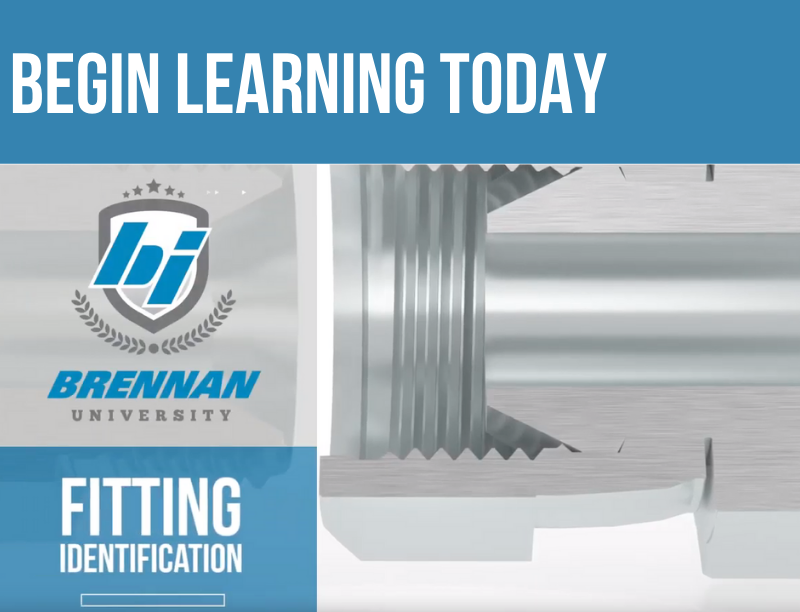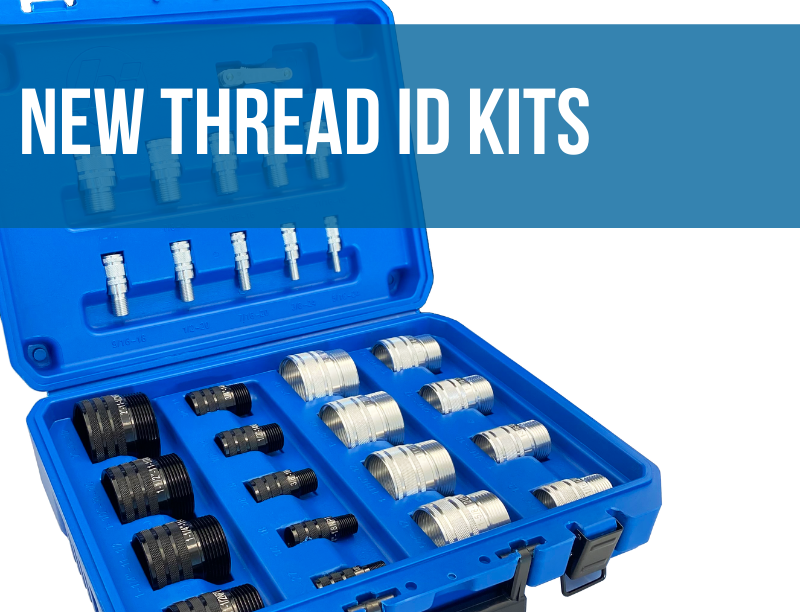The heart and arteries of heavy equipment and industrial machinery is the hydraulic system.
THE HYDRAULIC PUMPS ARE THE HEARTS. There are three types, each providing positive displacement of hydraulic fluid; gear pumps, piston pumps and vane pumps. They transfer measured amounts of pressurized fluid into the hydraulic system.
THE ARTERIES ARE MADE UP OF HYDRAULIC HOSES AND FITTINGS. Without the correct hose, fitting and
connection the system will leak, fail or burst. Carrying
medium to high working pressures, the enormous
power of a hydraulic system must be properly controlled.
Otherwise, a failure in the system can be catastrophic to equipment.
I. HOSE FITTINGS & FERRULES
ONE-PIECE HOSE FITTINGS
One-piece hose fittings have a ferrule that is pre-crimped onto the hose fitting. The advantage being that the collar will not slip out of alignment. This style also ensures the correct ferrule is matched to the correct fitting. One-piece hose fittings are good for basic applications and quick assembly.
TWO-PIECE HOSE FITTINGS
The ferrule used with two-piece fittings allows greater flexibility in hose selection and connection, including 1SN, 2SN and multi-spiral hoses which allow for multiple two-piece fitting and ferrule options to accommodate the specific application.
Stainless 316 two-piece hose fittings are the best selection to ensure corrosion resistance and long service life, especially in chemical and offshore applications. In these critical applications where 316 stainless is used, the end user may require the hose fitting manufacturer provide material traceability.
Two-piece hose fittings are used for these critical and exceptionally high pressure applications, particularly when there is the possibility of extreme hose vibration and/or pressure surges. When severe conditions are present near the fitting components, two-piece hose connections are highly important for providing a powerful assembly of the fitting and hose.
In these high pressure applications the hose is sometimes inside/outside skived (or 2 skive), creating a metal to metal connection on both the inside and outside of the hose.
COST BENEFIT TO DISTRIBUTORS
There is also a cost benefit to distributors when carrying stainless steel two-piece hose fittings versus one-piece hose fittings. Inventory cost can be significantly reduced because only two different types of hose tail styles need to be carried; standard and Interlock. It is more economical to stock a limited number of hose tails in varying sizes and end connections, which cover the vast majority of hoses and applications:
- Standard hose tails cover a broad range of applications from textile hoses, one and two wire
braided hoses, four spiral hoses (4SP), thermoplastic hoses and PTFE hoses. - Interlock hose tails are used with higher pressure multi-spiral hoses.
The cost of stainless ferrules is far less than the cost of their compatible tails. The key is to maintain a good balance of hose tails on hand with a large variety of ferrules that are made to work with specific hoses.
In other words, carrying more ferrules than hose tails allows for lower costs while still maintaining the inventory customers require. This is very important when there is a desire to reduce the cost of maintaining stainless steel components.
II. FITTING & HOSE COMPATIBILITY
Hydraulic fitting and hose compatibility is essential. The fitting connection area can experience the most stress in the system, from pinhole leaks to dangerous blow-offs when under pressure. That’s why it is imperative that the fitting and hose have compatible pressure ratings.
The working pressure of the system is based on the component with the lowest rated pressure. For instance, do not make the

mistake of mating a 5,000 PSI spiral-wire hydraulic hose with a low-pressure brass fitting. This is a prime example of grossly mismatching the fitting and hose which could cause catastrophic failure.
Selecting the right hydraulic hose and compatible connection for your application is vital. When the application will experience extreme conditions and corrosive environments, the fitting should be 316 stainless steel.
III. CHOICE IN THE ASSEMBLY PROCESS OF HYDRAULIC HOSE & FITTINGS
Special attention must be given to hose assemblies. The two preparation options to choose from are skiving or non-skiving of the hose.
SKIVING
Skiving a hydraulic hose is the process of using special equipment and tooling to shave a predetermined depth of the OD and ID of the hose. Some medium pressure hose fittings require only external
skiving (or single skive) in order for the ferrule and hose fitting to mate correctly. Higher pressure hose applications may require internal and external skiving.
Skiving a hydraulic hose ensures a metal to metal connection between the hose fitting and hose resulting in a highly reliable connection.
Skiving lets the ferrule of the hose fitting assembly bite into the wire braiding of the hose instead of just crimping to the outside diameter (OD) of the hose cover.
If the hose is not skived the thread of the ferrule is forced into the hose cover, biting into the rubber, which could result in a less reliable connection.
Once the assembly has been set, it is essential to correctly crimp the fitting onto the hose using the hose fitting manufactures’ crimp specifications. Look for fitting manufacturers that can provide crimp specifications for multiple hose manufactures. If the fitting manufacturer does not provide the crimp specs for a specific hose the installer must make an adjustment. In these cases it is critical that high pressure hoses are pressure tested to ensure the installation is accurate and secure.
NON SKIVING
Non-skiving is when the hose and fitting connection is designed ready to assemble without the skiving process, with no removal material from the hose. If the hose is not skived the thread of the ferrule is forced into the hose cover, biting into the rubber, which could result in a less reliable connection.
IV. FITTING MATERIAL
It’s understood that fittings need to yield enough to crimp without cracking and be strong enough to maintain thousands of pounds of pressure, yet they must also hold up to millions of cycles of pressure fluctuations.
The proper choice of fitting material and quality is extremely important and must be selected to match
the application.
STAINLESS STEEL is the best choice for corrosive environments where machinery is constantly exposed to the environment, marine applications or applications with high acid exposure. Stainless steel is also less likely to split or crack under these conditions.
BRASS fittings are also resistant to corrosion but are normally used in lower pressure applications where the temperature range does not exceed 400° F.
CARBON STEEL is commonly used on agricultural, industrial and construction hydraulic applications. Carbon steel offers a cost advantage or stainless steel however they are less resistant to corrosion and therefore not the optimal choice under certain environmental conditions.
ALUMINUM is also used to produce hydraulic fittings but is not frequently used in hose fittings. Aluminum fittings are normally chosen for their light weight.
CONCLUSION
A hydraulic system’s design needs to focus on the required working pressure of the application. To do so, the working pressure of the components must coincide with the system requirements. The components for the system are then selected to ensure safe and acceptable service life.

There are a number of factors to consider when selecting
the hose fitting, including the compatibility of the fitting to the hose, one or two piece design and the
correct assembly.
SOURCES:
Hose Assembly Tips
Hydraulics & Pneumatics
International Organization for Standardization
Machine Design
Machinery Lubrication
Volz USA





